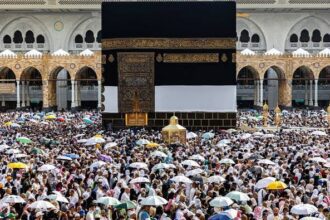The Prophet’s Mosque (peace be upon him) in Madinah, Saudi Arabia, stands as a beacon of Islamic spirituality and architectural grandeur. One of its most striking features is its ten towering minarets, from which the call to prayer echoing the truth and tranquility of Islam is broadcast five times a day, touching the hearts of millions.
Historically, before the invention of loudspeakers, muezzins would ascend these minarets and deliver the adhan (call to prayer) from various points around the mosque, ensuring it reached all corners of the city. Today, while modern technology has taken over this task, the minarets continue to serve their traditional role. Carefully positioned loudspeakers now ensure that the call reverberates in every direction without obstruction.
According to the Saudi Press Agency, the ten minarets are strategically oriented: four face north, one each points northeast, northwest, southeast, and southwest, while two are directed east and west. Each structure rises five stories high, symbolizing the phases of expansion the mosque has undergone over the centuries.
These minarets are not only functional but are also architectural masterpieces. Built in a uniform style, they reflect the various stages of Islamic architectural evolution. Notably, the central minarets on the southeastern side adjacent to the iconic Green Dome hold special significance and are considered the most prominent among them.
Among the named minarets, those on the northeastern side are referred to as Al-Sinjariya, while those to the northwest are known as Al-Majidiya, each carrying historical and cultural weight.
Beyond the minarets, the Prophet’s Mosque showcases an exquisite blend of Islamic calligraphy and intricate carvings on its walls. These artistic elements not only highlight the richness of Arabic script but also stand as a lasting tribute to the enduring legacy and cultural magnificence of Islamic art.














